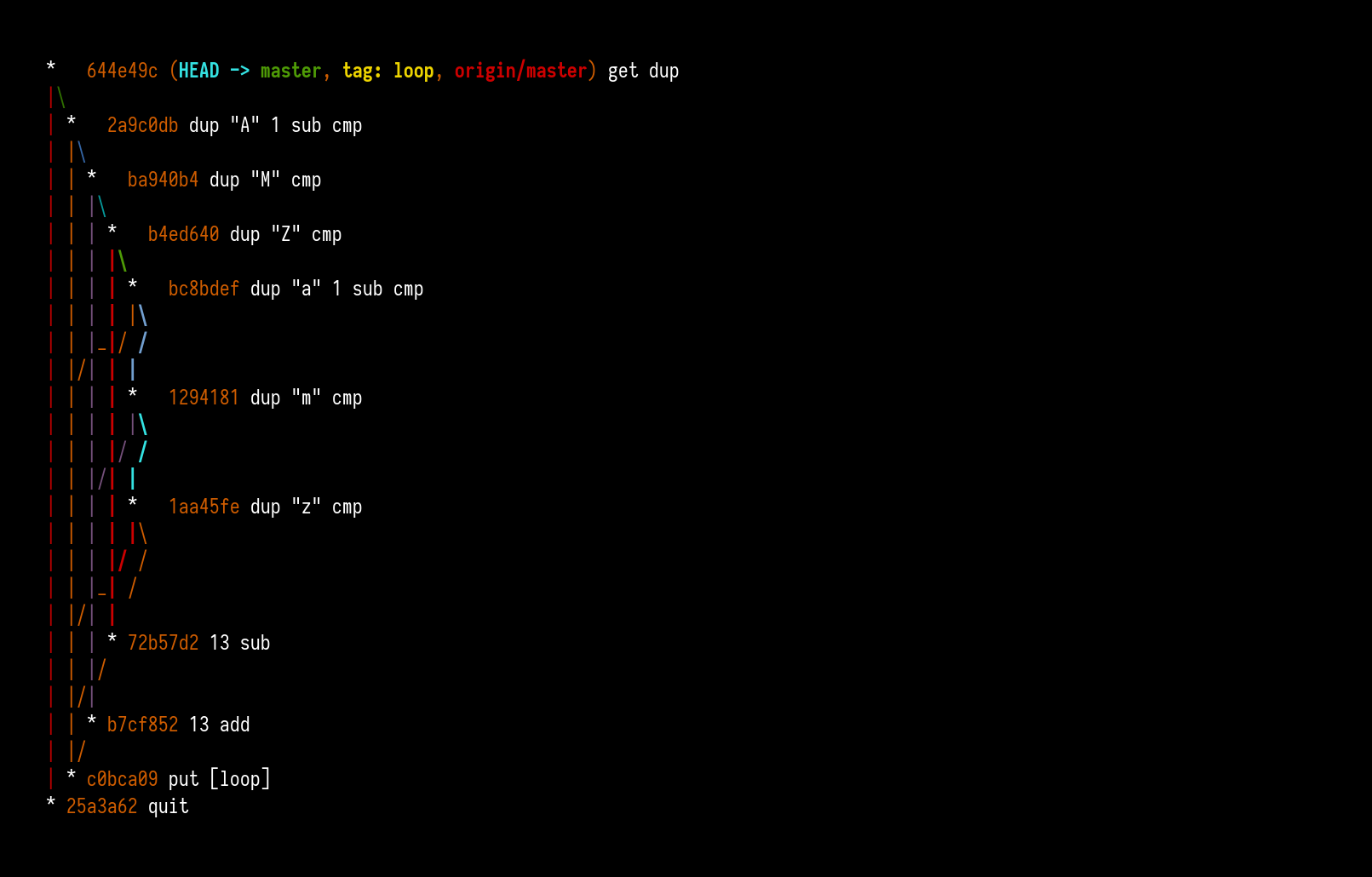legit
Ever since I gave my first talk about esoteric programming languages, I wanted to create my own one. Well, some years later, at the Recurse Center, I wanted to learn how to build compilers with LLVM, so that seemed like a good opportunity to try that! Presenting:
Programs written in legit are defined entirely by the graph of commits in a Git repository. The content of the repository is ignored.
legit is designed so that all relevant information is visible when running git log --graph --oneline. For example, here is “hello world”:

Thanks to rohieb for the original idea! Influences for the design of this language include Folders, Befunge, Brainfuck, and Elymas.
A fun consequence of programs defined by a Git history is that you can’t properly track versions, because they already are Git repositories. All you can do is force-push a new version to GitHub.
You can find implementations of legit, as well as some example programs, on GitHub: https://github.com/blinry/legit. The entry in the Esolang wiki is at https://esolangs.org/wiki/Legit.
Here’s how the language works:
Memory
In each legit program, two data structures are available: A stack, and a brainfuck-like endless tape, with a head moving on it. Both hold signed integers.
Control flow
Execution starts at the commit pointed to by the master branch. Commit messages can contain a series of instructions, seperated with spaces, which are executed one by one. Only the first line is considered, so lines after that can be used for comments.
- If a commit has only one parent, execution will continue there after executing all instructions in the current commit.
- If a commit has multiple parents (numbered 0, 1, 2, …), the top stack element will be popped. If that element is n, to go n-th parent, or to the last one, if n is outside of the available range.
Instructions
For all instructions, popping from the empty stack will return a value of 0.
Control flow:
[<tag>]: jump to the specified Git tag. For example,[loop]will jump to the tag loop.quit: stop the program.
I/O:
get: read a char from standard input and place its ASCII value on the stack. On EOF, push a 0.put: pop top stack value and write it to standard output as a char. The value is always truncated to an unsigned byte.<Number>: push the specified integer on the stack. For example,42will push the value 42."<Letters>": unescape string, then push the individual ASCII characters on the stack. For example,"Hi\n"will push the numbers 72, 105, and 10.
Stack operations:
dup: duplicate top stack valuepop: pop top stack value and discard itadd: pop two topmost stack values, add them, push result on the stacksub: pop two topmost stack values, subtract top one from bottom one, push result on the stackcmp: pop two topmost stack values, pushes 1 if bottommost one is larger, 0 otherwise
Tape operations:
read: place value of current tape cell on the stackwrite: pop top stack value and write it to the current tape cellleft: pop top stack value, move tape head left for that many placesright: pop top stack value, move tape head right for that many places
Examples
I’ll be honest with you: I got tired of writing Git commands by hand to create legit programs. One consequence of the execution going top-down is that you have to write your programs backwards, and each time I’d make a typo, I’d have to start all over, because the commits above that would be invalidated. So… I started to write shell scripts, which would then generate my legit programs. You can generate the examples like this:
make -C examples
Alternatively, you can also clone them directly from GitHub:
hello, a simple hello world program:

rot13, a ROT13 implementation:

brainfuck, a fully-functioning Brainfuck interpreter, conveniently proving that legit is Turing complete!

Implementations
The repository provides both an interpreter (better suited for development and debugging purposes) and a compiler (which produces highly efficient binaries).
For both, you’ll need Ruby, and the “rugged” Gem:
gem install rugged
Running the interpreter
To execute a program, run
ruby interpreter.rb examples/hello/
Running the compiler
The compiler compiles a legit program to LLVM IR. You can then use LLVM tools to build binaries for all plaforms where you have a C standard library available (legit will be linked with exit, getchar and putchar).
First, run the compiler to create a .ll file:
ruby compiler.rb examples/hello/
And then, run a tool like clang to optimize it and produce a binary:
clang -O3 hello.ll -o hello
As an alternative to the second step, you can use the provided Makefile and simply run make hello.
The final challenge
So, after I had written that Brainfuck interpreter, I thought would be the final milestone for my language. But then, Kate-Laurel sat down next to me and asked: “Could you write a quine?”
So this is the challenge I now give to you, dear reader: Write a legit program that prints the Git commands required to create itself! Good luck.
Aftermath
Turns out at least two people were up to the challenge, and actually wrote a quine! I can’t believe it!
One is by remuladgryta, you can find a script to generate the legit program here! Daniel Temkin published a neat article about legit and remuladgryta’s quine on esoteric.codes!
Another one is by LegionMammal978, you can find the legit program here!
Comments?
Send a message to @blinry@chaos.social or drop me a mail at mail@blinry.org. Also, you can support me on Patreon or subscribe to my newsletter!